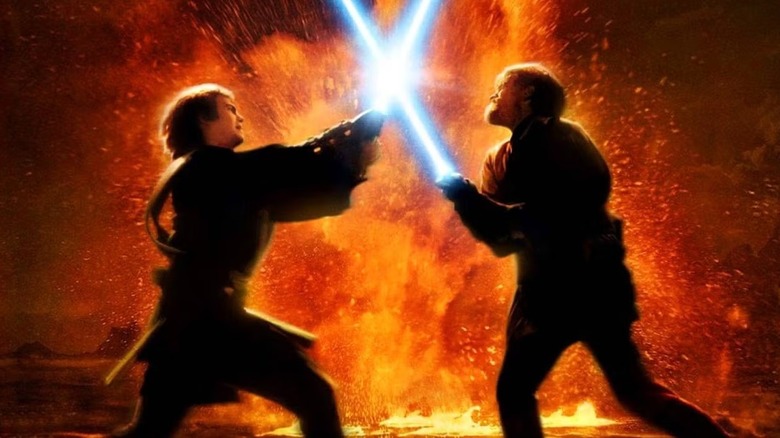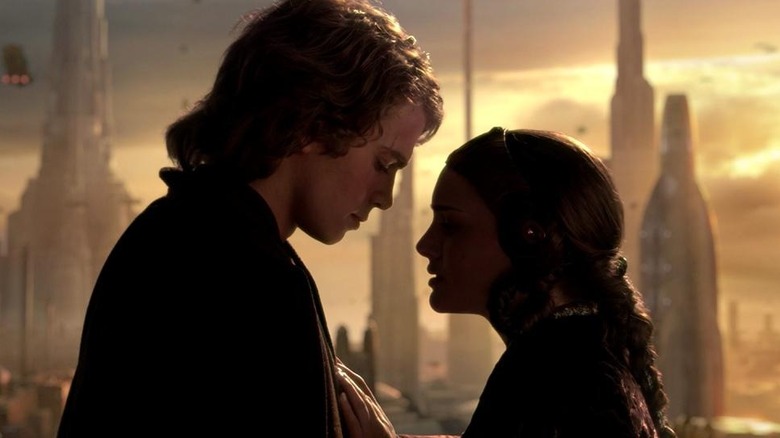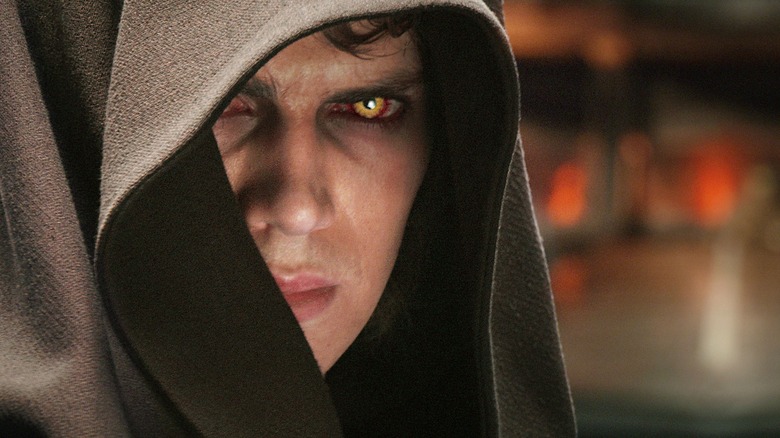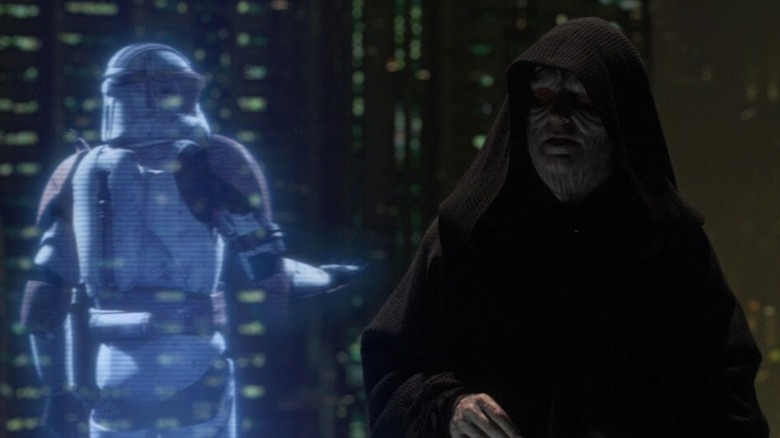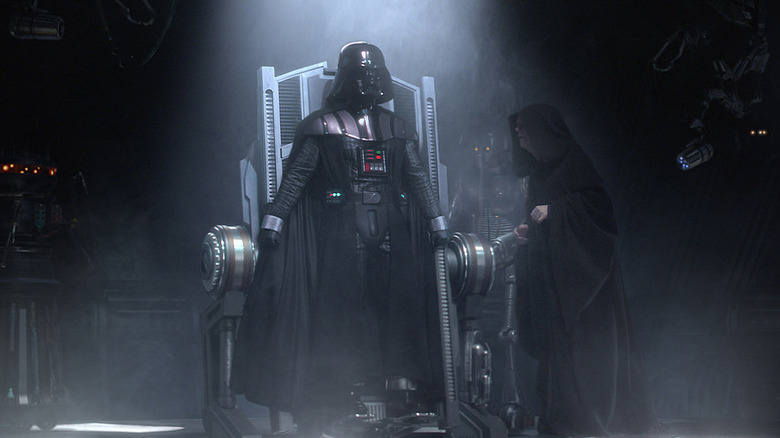Why Revenge Of The Sith's Box Office Success Is Key To The Star Wars Legacy 20 Years Later
(Welcome to Tales from the Box Office, our column that examines box office miracles, disasters, and everything in between, as well as what we can learn from them.)
"When I said I was going to do the prequels, everybody said, 'That's great, we get to see Darth Vader kill everybody.' And I said, 'That's not the story.'" Those are the words of "Star Wars" creator George Lucas speaking with Rolling Stone in 2005 ahead of the release of "Revenge of the Sith," the finale to his ever-divisive prequel trilogy. "When I announced that the first story was going to be about a nine-year-old boy, everybody here said, 'That's insane, you're going to destroy the whole franchise, it's "More American Graffiti" all over again.' And I said, 'Yeah, but this is the story.'"
Lucas had earned the right to do as he pleased. "Star Wars" was a multi-billion-dollar multimedia enterprise. 1999's "The Phantom Menace" was one of the biggest movies of all time up to that point, eventually passing the $1 billion mark globally through its various re-releases. Unfortunately, the critical response was far from glowing, making the tale of the rise and fall of Anakin Skywalker a bit uneven. Be that as it may, Lucas was going to end this trilogy on a high note. More than that, he was going to ensure "Star Wars" had a future, with this movie serving as an ever-important lynchpin.
In this week's Tales from the Box Office, we're looking back at "Star Wars: Revenge of the Sith" in honor of its 20th anniversary. We'll go over how Lucas crafted the story, how it became the darkest entry in the franchise up to that point, what happened when it hit theaters, what happened in the aftermath of its release, and what lessons we can learn from it two decades later. Let's dig in, shall we?
The movie: Star Wars: Revenge of the Sith
The film picks up years into the raging Clone Wars. Anakin Skywalker (Hayden Christensen) learns that Padme (Natalie Portman) is pregnant. Given their secret marriage, Anakin fears for his family's safety. All the while, he's in the middle of a tense situation between the Jedi Order and the Senate. As visions of Padmé's death persist, Anakin becomes tempted by the Dark Side, leading him down the path to becoming Darth Vader.
"I'm not a great writer," Lucas said to Vanity Fair in 2005. "I'm trying to tell a story using cinema, not trying to write a great script. I use the script as a blueprint." Critics and audiences who helped make 2002's "Attack of the Clones" a low point commercially for "Star Wars" at the time would have likely agreed. All the same, Lucas had a story to finish.
Lucas had the story outlined for decades, which is why 1977's "Star Wars" was later subtitled "Episode IV – A New Hope." That always implied the existence of three other episodes. Even so, after Episode I and Episode II were in the books, Lucas had trouble focusing the story that would make its way to the screen in "Revenge of the Sith." As he once explained:
"The first script I wrote had stories for everybody, and I cut it down, and we had a script. But when we cut it together, there were still problems. Finally, I said, 'Okay, let's be even more hard-nosed here and take out every scene that doesn't have anything to do with Anakin.' But that causes you to juxtapose certain scenes that you were never contemplating juxtaposing before."
Star Wars goes dark with Revenge of the Sith
That decision to hyper-focus on the Anakin story is partially why ideas like a young Han Solo cameo were scrapped along the way. It's the movie that fulfills the promise of this trilogy; getting to see Anakin Skywalker become Darth Vader. Despite the mixed response to "Attack of the Clones," that was always going to give this movie an edge in the marketplace.
Speaking of edge, Lucas also wasn't going to be pulling any punches with Episode III. Jar Jar Binks made Episode I more of a movie for kids. In this movie, Anakin literally killed younglings at the Jedi Temple. This was going to be arguably the most adult "Star Wars" movie to date. To that end, "Phantom Menace" and "Attack of the Clones" both hit theaters with a PG rating. "Revenge of the Sith" earned a PG-13. In that same Vanity Fair piece, Lucas made it clear that it didn't bother him one bit:
"I don't really mind a PG-13. This one is a little tougher, and I think children, young children especially, should be warned that this is not your average Star Wars. It's a lot darker. There's a lot more scary stuff in it. It's brutal in places, and they should be aware of that."
Was Lucas deliberately making some sort of course correction based on the reception to the previous two movies? Probably not. Either way, he saved the best of his prequel trilogy for last.
The financial journey
As anyone might expect, Fox and Lucasfilm pulled off one heck of a global marketing campaign for this one, with numerous product tie-ins, a massive press tour, the whole shebang. There was one hiccup, however, when a full, workpring copy of the film leaked online just days ahead of the premiere. To what degree that impacted the box office we can never now, but this was the internet in 2005 and not 2025. That impact would be much larger now.
Fox released "Revenge of the Sith" in theaters on May 19, 2005, giving audiences the full Thursday before the weekend to see the film. That paid off, as it made $50 million domestically before Friday even rolled around. Bolstered by generally favorable reviews and the notion that this might be the last "Star Wars" movie ever, audiences rallied around the film.
With no competition, to speak of it made $108.4 million on opening weekend, easily topping the charts. Episode III held strong throughout the summer and didn't depart the top 10 on the charts until Tim Burton's "Charlie and the Chocolate Factory" arrived in mid-June.
"Revenge of the Sith" finished its original run with $380.2 million domestically to go with $469.7 million internationally for a grand total of $849.9 million globally. It was the second-biggest movie of 2005 overall, trailing only "Harry Potter and the Goblet of Fire" ($895.9 million). For context, "Attack of the Clones" made $656.6 million. That's a sizable increase and, even against a sizable $113 million budget, it was a victory lap for Lucas.
As the prequel trilogy ended the Star Wars universe expanded
It may seem hard to imagine now but at the time, this seemed like it could be the end for "Star Wars," at least as a theatrical concern. However, Lucas had no intention of letting his baby wither and die. Instead, he hatched a plan to bring a galaxy far, far away to television. His ambitious live-action "Star Wars: Underworld" didn't pan out, but "The Clone Wars" sure did.
While Lucas (somewhat surprisingly) had a difficult time selling "Star Wars: The Clone Wars" to Cartoon Network ahead of its premiere in 2008, it eventually did make its way to air. Set between the events of "Attack of the Clones" and "Revenge of the Sith," it was a deep, multi-season exploration of these characters in the prequel era. It also resonated deeply with its audience. That audience largely being younger kids. Those kids were probably aware of the original trilogy but increasingly, the prequel era was becoming "Star Wars" to them.
It's hard to know what Lucas intended, but this era became a truly rich area for "Star Wars" storytelling. From the Tragedy of Darth Plagueis the Wise to the Siege of Mandalore and everything in between, there are now hours and hours worth of beloved stories taking place during this timeline, all culminating in the events of "Revenge of the Sith."
Revenge of the Sith (and the prequel era) became beloved with time
The importance of the trilogy's reclamation cannot be overstated. Seven seasons of "The Clone Wars" and all of the other prequel era storytelling over the years have only made "Revenge of the Sith" all the more important to "Star Wars," particularly for the generation that grew up with the prequels. It's now an unquestioned pillar of the franchise without caveat.
That's why "Revenge of the Sith" made more than $25 million in a single weekend when it was re-released in theaters earlier this year, ranking as one of the most successful openings for a theatrical re-release in history. That's why Hayden Christensen was met with an unbelievably warm response when he appeared at Star Wars Celebration in 2017 for the first time in 15 years. That's why there are countless loving memes populating the internet stemming from this movie. Say "Hello there" to anyone of a certain age and there's a decent chance they'll respond with, "General Kenobi."
"I do think that if you watch 'Revenge of the Sith' accepting what Lucas set out to do, there's no question that this is his masterpiece," Rick Stevenson wrote for /Film earlier this year as a self-proclaimed "prequel kid." He's not alone. In no small part because this movie stuck the landing, the prequels gave "Star Wars" decades worth of life, instead of the franchise running the risk of losing cultural relevance. It is without question a key, valuable piece of the series' legacy.
The lessons contained within
It's easier than it's ever been to re-evaluate the prequel trilogy. At the time, there was no guarantee we'd ever have more "Star Wars" movies. That all changed when Lucas sold Lucasfilm to Disney in 2012 for $4 billion, with "The Force Awakens" and everything else that followed giving us more "Star Wars" than we'd ever had before. That casts these movies in a different light. They weren't the last "Star Wars," they were just part of the ever-expanding galaxy of stories.
No matter where one lands on "Revenge of the Sith," or the other prequel movies, one thing is crystal clear now that wasn't clear then. It's no longer reasonable or fair to treat these movies as some sort of dark mark on the legacy of "Star Wars." For one, they were commercially successful on a level relatively few movies have ever been. More importantly, millions of fans around the world — particularly younger fans — cherish these movies. They love these characters. This is "Star Wars" to them. Those same fans added an awful lot of value to Disney's investment. No two ways about it.
Beyond that, in the Disney era of Lucasfilm that has seemingly been paralyzed with relative indecision ever since the divisive response to 2017's "The Last Jedi," there is something refreshing about Lucas flexing his creative might and making a movie at the largest scale on his own terms. As he said, "This is the story." Not for nothing, but that story proved to be far more valuable than he or anyone else realized at the time.
